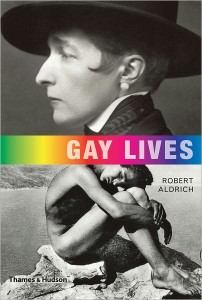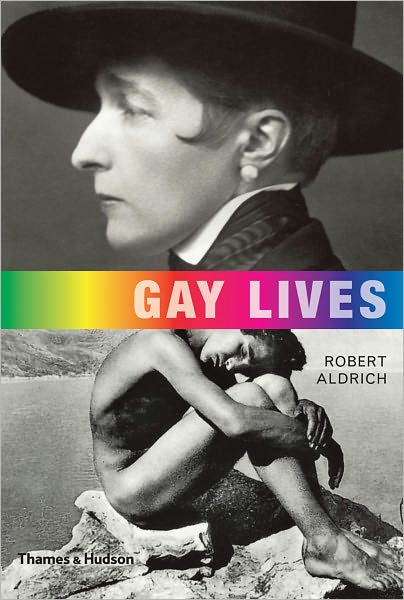 Gay Lives
Gay Lives
by Robert Aldrich
Thames & Hudson. 304 pages, $29.95
SOME BOOKS are meant to be read cover-to-cover: Madame Bovary, War and Peace, Fifty Shades of Grey. Others may be dipped into at any point, since there is no continuous narrative, only—as in the case at hand—self-contained accounts that take a few pages each. Gay Lives, by Robert Aldrich, a professor of European History at the University of Sydney, belongs to the latter category.
Handsomely printed and illustrated, Gay Lives is a panoramic view of over eighty gay men and women throughout history and across global boundaries. In its modest way, it is a perfect introduction to (or review of) GLBT people, some of whom are iconic—Walt Whitman, Oscar Wilde, Sappho—while others are rather marginal and presented, perhaps for the first time, to a broad readership rather than a specialized academic one. For example, Khnumhotep and Niankhkhnum, who lived in the age of the pharaohs, have names that do not trip off the tongue, yet they may present the first recorded instance of same-sex affection via a shared burial site with wall carvings that have survived over 4,000 years.
Who is the audience for such a book, a text that’s neither encyclopedic in its coverage nor obviously representative in its selections? It could be any gay reader’s thumbnail reference to our community’s heroes and heroines across the ages; it could instill pride in a young person just coming out; it could comfort a family coming to terms with a gay or lesbian child or sibling. While not produced in deluxe coffee-table style, Gay Lives’ illustrations are historically interesting, often beautiful, and well integrated with the text.
Let me admit to some skepticism when the book first came into my hands. While I immediately admired its conservative design, high quality printing, paper stock, and rich illustrations (128 reproductions of paintings, lithographs, drawings, sculptures, engravings, and manuscripts, nearly half in color), I wondered at Aldrich’s organization with twelve chapters that are only roughly chronological. So we discover that Chapter Three, “Founding Fathers and Mothers”—which includes relative moderns like André Gide, E. M. Forster, and Radclyffe Hall—is sandwiched between “From the Middle Ages to the Enlightenment” and “The Fin-de-Siècle and Belle Époque.” Couldn’t Gide fall into the fin-de-siècle? L’immoraliste appeared in 1902. And isn’t Christopher Isherwood a bit too contemporary to be thought of as a “founding father,” especially if we consider his own position as Forster’s acolyte and eventual literary heir?
While the beginning chapters deploy a clear chronological scheme, later ones are more thematic: “Women Who Loved Women”; “Visions of Male Beauty”; “Japonisme”; and “Love in the Levant.” In each of these, we cover large swaths of history. “Women Who Loved Women,” for example, begins with Eleanor Butler and Sarah Ponsonby, the late 18th- to early 19th-century “Ladies of Llangollen,” who received many celebrated callers and, according to one, had “selected this charming spot for the repose of their now time-honoured virginity.” The chapter moves to the more aggressively erotic Anne Lister (1791–1840) and to last century’s Sylvia Townsend Warner, the writer whose long relations with Valentine Ackland, a writer and poet, survived the mannish Ackland’s several detours with other women.
Similarly, “Japonisme” begins with the erotic littérateur Ihara Saikaku (1642–1693), whose book The Life of an Amorous Man details the experiences of a well-bred gent who had “sex with 3,742 women and 725 young men over the course of sixty years.” The chapter ends with Yukio Mishima (1925–1970), certainly the Japanese novelist most widely read in the West (Confessions of a Mask), and Tamotsu Yato (1928-1973), a colleague of Mishima’s who produced several volumes of photography that extolled the virility of Japanese bodybuilders and provincial laborers.
Each biographical sketch manages to fold inside its appropriate historical context. Take, for example, Chen Weisong, a 17th-century Chinese poet who entered the imperial service under Emperor Kangxi and wrote poems about his younger lover, nicknamed “Purple Clouds,” reputed to be “the most alluring actor of his age.” Writes Aldrich: “At least ten emperors of the ancient Han dynasty openly engaged in same-sex affairs, male brothels operated for centuries in Beijing and other cities, and male marriages were occasionally celebrated in the province of Fujian. … Many scholar-officials like Chen consorted openly with male partners, and jokes and caricatures poked fun at mandarins for losing their hearts to handsome youths.”
Aldrich also recounts the complicated case of the Chevalier d’Eon, a well-educated youth whose noble connections first won him a diplomatic appointment to Russia, eventually becoming Minister Plenipotentiary to London while secretly spying on the British for Louis XV. Piqued that he didn’t receive a permanent ambassadorship, d’Eon stayed on in London and became the focus of rumors about his gender, “adding to his notoriety and leading people to place bets totaling tens of thousands of pounds” as to whether or not he was actually a woman. To get him out of England, the French negotiated a pension if d’Eon would return home as a woman, relinquish “all secret documents,” and abandon his political career. The chevalier returned to the family house in Burgundy where, as a chevalière, she asked the French monarch, now Louis XVI, to raise “a company of women soldiers to fight in the American War of Independence.” Request denied. D’Eon lived out the remainder of life as a woman after returning to London, sharing her residence “chastely with an admiral’s widow” and selling her “vast” library to keep her head above water. Withdrawn from the social world, she continued to write and claimed to have been born a woman. Yet on her death, while being prepared for burial, the evidence was unmistakable: she had a penis.
Gay Lives should make an indispensable resource for the high level of its scholarship, the fluency of its writing, and the cultural breadth of its selections. Does it miss important figures? Undoubtedly. I miss, for example, the New Yorker journalist and chronicler of pre-war Paris, Janet Flanner, who is nowhere in view. But it remains no small accomplishment for Aldrich to travel from cross-dressing 19th-century painter Rosa Bonheur to self-immortalizing photographer Claude Cahun, from Southern writer Carson McCullers to pre-Stonewall lesbian activist Del Martin, while giving us informed sketches of fashion designer Yves Saint Laurent and Cuban novelist Reinaldo Arenas. This could possibly be the best GLBT cruise you could take without leaving the comforts of home.
Allen Ellenzweig is the author of The Homoerotic Photograph and a frequent contributor to this journal.






